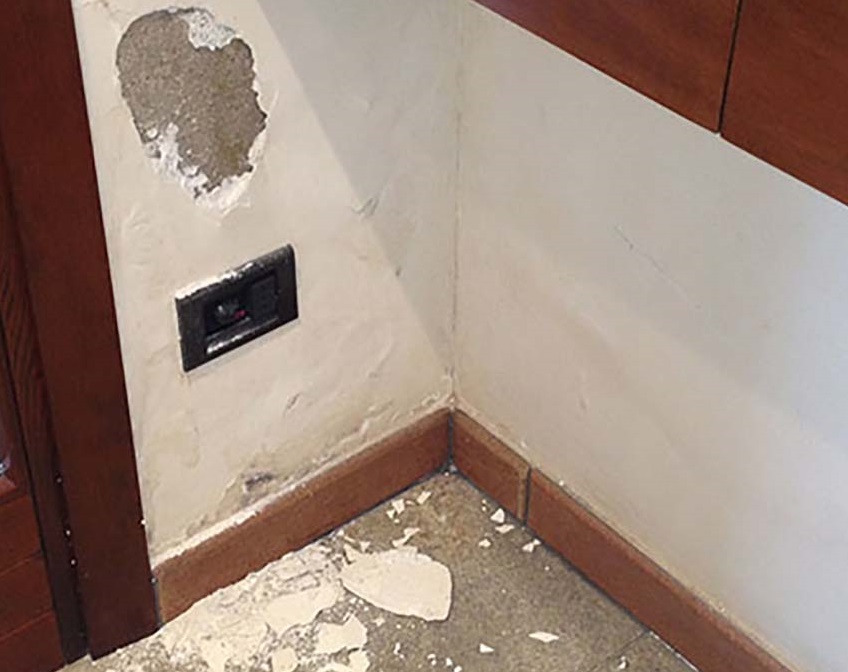
Repair damp walls. Super bonus 110%?
Repair damp walls. Super bonus 110%?
The presence of capillary rising damp in the walls can lead to disputes and illnesses. Thanks to the Superbonus it is easier to eliminate it.
Ing. Cristian Angeli 03/15/2022
There is a reason if, once upon a time, the noble floor of the buildings, the one where the lord and his court lived, was always on the first floor: the upper floors were uncomfortable to reach with the stairs, while the ground floor was often unhealthy. and smelly, therefore the servants lodged there.
In fact, the problem of humidity in masonry structures is as old as man. Today we know the causes and we are able to eliminate it in new buildings. In historical buildings, however, despite the evolution of technologies, it is not always easy to keep under control.
Moisture in the walls, the causes
The causes of humidity can be many. Some may be accidental in nature, such as ruptured or leaked pipes and sewers. Others can be linked to the construction process or to the structure-soil relationship, as occurs in the case in which the walls and foundations are not well waterproofed and are placed in contact with undrained soils.
In general, it should be borne in mind that the humidity present in the construction elements, whatever the triggering cause, derives from the physical nature of the materials that make up the walls, i.e. bricks, mortar and concrete, or reinforced concrete. Porous materials characterized by large volumetric percentages of voids.
It is therefore normal that, if placed in contact with water, they soak like sponges and then, by capillarity, allow the water to rise upwards (rising damp). Consider that, for example, a brick wall can have up to 30% voids. This means that, if immersed in water, it can contain up to 100 liters per square meter.
Regardless of the causes that originate the phenomenon of humidity, the following effects are almost always found:
- Erosions, chalking, saline efflorescence;
- Swelling and detachment of the plaster;
- Molds;
- Lowering of the insulating power;
- Unhealthiness of the premises.
Moisture in the walls, the remedies
Before talking about the remedies, it is always necessary to correctly frame the causes of the problem, through visual and instrumental diagnostic investigations carried out by competent personnel.
It is possible to intervene with mechanical methods, based on horizontal barrier systems at the rising of the water, or with chemical methods, which consist in the introduction into the wall of liquid chemical formulations that polymerize inside the capillaries of the material, thus preventing the passage of the water.
The chemical techniques differ on the basis of two principles of action: closing of the pores with an occluding effect (by means of polyurethane and epoxy resins); reduction of the absorption power of capillaries with hydrophobic effect (by means of silicone resins).
Tax breaks to eliminate humidity
If it is decided to carry out remediation work, the possibility of benefiting from tax deductions, accruing receivables that can be transferred to financial institutions until 31/12/2024 as required by the 2022 budget law, is strictly related to the cause from which the humidity and from the problems it creates for the building.
If the humidity determines forms of degradation such as to reduce the “original strength of structural elements in masonry and / or reinforced concrete and / or steel”, then it is possible to access the Super Sismabonus, with a 110% deduction of the expenses necessary to eliminate it and to restore the original conditions of the structure.
This was foreseen by the Monitoring Commission on Sismabonus established at the Superior Council of Public Works with opinion no. 3/2021.
The weakening of a structure due to humidity can occur, for example, in the case of a reinforced concrete retaining wall, whose metal reinforcements can oxidize (with consequent reduction of the resistant section) due to the effect of rising water.
If the humidity present in the masonry derives instead from interstitial or superficial condensation phenomena then it is evident that the decisive intervention will probably be the creation of an external coat, with which the thermohygrometric structure of the wall can be re-balanced.
The expense can be tax deducted (or transferred to the bank) at 110% or 65%, in relation to the effectiveness of the intervention in terms of energy class jump and the objective and subjective requirements of the property.
Finally, if the building intervention was not set up neither in an anti-seismic nor in an energy key, but was rather aimed only at solving the specific problem with one of the techniques set out above, the 50% deduction of the expense will be available through the restructuring bonus, also ‘it can be transferred to the bank, provided that the works are legitimized by a suitable building title.
The evaluation of the causes and effects of the humidity present in a building, as well as the identification of the most suitable interventions to eliminate it, together with the definition of the applicable tax deductions, represent a complex activity, which must always be carried out by qualified professionals.
Source: https://www.condominioweb.com/risanare-i-muri-umidi-superbonus.19084
GECOSEI by Giuseppina Napolitano


